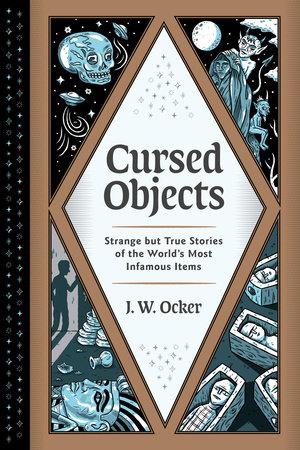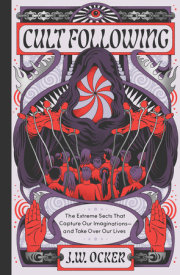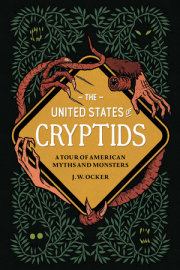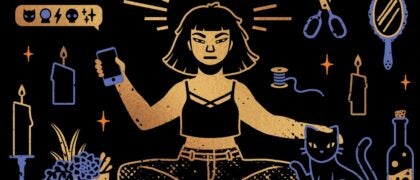Headfirst into the Accursed
I hate to be the one to tell you this, but many seemingly innocuous objects will make your life suck. They might even kill you. We call these objects cursed. A cursed object could be a vase, a chair, a painting, a doll: things we all have around our houses, in our attics and basements. They could be in museums, separated from the general populace by a thin piece of glass. They could be out in the open — masquerading as ordinary statues or rocks, for instance. Anything can be cursed, and you rarely know until it’s too late. Good thing you have this book to help you.
So what is a cursed object? In lore, it’s an inanimate item that brings misfortune, harm, or death to its owners or those with whom it comes in contact. An object can become cursed because someone with powerful and mystical knowledge hexes it. Or it could have been present at a scene of great tragedy, absorbing dark energy like a battery and powering other tragedies going forward. It could be inherently evil from the start, all the way down to its MADE IN CHINA sticker. Or it could all just be in our heads.
You don’t have to believe in cursed objects to be fascinated by them. Because another, less paranormal definition of a cursed object is an object that gathers stories to itself — and more specifically, tragedies. Objects are intimately connected to people. We make them, live with them, use them, love them, and are sometimes even buried with them, and people continuously find themselves in the midst of tragedy. Cursed objects are those items that have simply been the mute witnesses to more tragedies than other items. They then become devices for remembering those stories and provide opportunities for retelling them.
And don’t get me wrong. There’s magic in that, too: that a simple oak chair, out of millions of oak chairs in the world, would be connected to so many stories of misfortune and death (see Busby’s Stoop Chair, page 123). The idea that cursed objects operate as storytelling mechanisms for tragedy in culture is at the heart of this book, although that doesn’t mean we won’t have fun with the notion that there might be other, less explainable, and more sinister forces at work.
In this book, we’ll look at crystal skulls and creepy dolls, tiny stone heads and ancient weapons. We’ll cover the infamous, including Annabelle the Doll (page 173) and the Hope Diamond (page 18), as well as the obscure. Ever heard of the Little Mannie with His Daddy’s Horns (page 134)? Probably not. I’ve risked visiting a few firsthand for you. I even brought one into my home. We’ll dip into the business of cursed objects, where cursed is prized as a marketing term and cursed objects are collected, displayed in museums, and even sold on eBay. We’ll learn that even technology and digital artifacts can be cursed.
Before we begin, we’ll need to define some terms.
Cursed is often used synonymously with
haunted and
possessed, but these three qualities are distinct. For our purposes, the difference is one of intelligence. Cursed items have none. They’re objects that have become bad luck via someone who has purposefully cursed them or by happenstance. By contrast, a haunted object has a spirit intelligence attached directly to it, and a possessed item is similarly inhabited, in this case by a demonic entity (although some say that an object cannot technically be possessed, only humans can . . . lucky us). Both haunted and possessed objects can function practically as cursed objects if they bring misfortune to enough people, but if they merely act spooky, then they’re not cursed.
Take, for instance, the wedding dress of Anna Baker at the Baker Mansion History Museum in Altoona, Pennsylvania, or the haunted mirror at the Myrtles Plantation in St. Francisville, Louisiana. Both objects are mentioned regularly in articles about cursed items. But stories of the Anna Baker wedding dress mostly involve the dress moving around on its own and the specter of its owner popping up here and there. The haunted mirror at the Myrtles Plantation reflects creepy figures and sometimes appears smudged with ghostly handprints. Both objects are spooky as hell, but neither causes the serial misfortune that a cursed object is supposed to.
For the purposes of this book, I’ve also ruled out cursed objects without detailed curse stories. For instance, the Villa Zorayda Museum in St. Augustine, Florida, displays an Egyptian rug made entirely out of cat hair that was once wrapped around a mummified human foot (also on display). Some posit that it’s the oldest existing rug. Others posit that it’s cursed and that anyone who steps on the rug will die (hence why the rug is currently hung on a wall). However, its entire curse story was contained in those three sentences. A fascinating object, but difficult to wring a narrative essay out of.
Now, more than objects can be cursed. People can. Places can. But for the purposes of this journey, I’m interested in objects that are cursed. I generally followed the terrifying maxim, “Could I inadvertently pick it up at a flea market or an antiques store and bring it into my home?” or, “Could I
brush up against it in a museum and be forever damned?” And, with a handful of notable exceptions, that’s exactly what is included in this book.
So, beware. Because it’s not just ancient artifacts looted from old coffins buried deep in exotic climes that will ruin your life. It could also be the “I Hate Mondays” coffee mug on your desk that your mom bought you at a garage sale.
Copyright © 2020 by J. W. Ocker. All rights reserved. No part of this excerpt may be reproduced or reprinted without permission in writing from the publisher.










